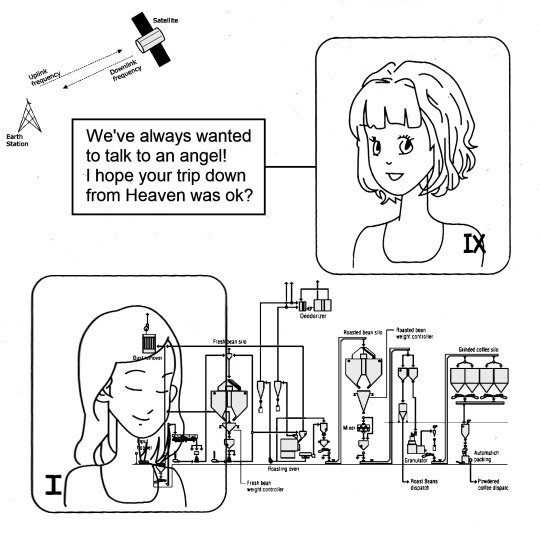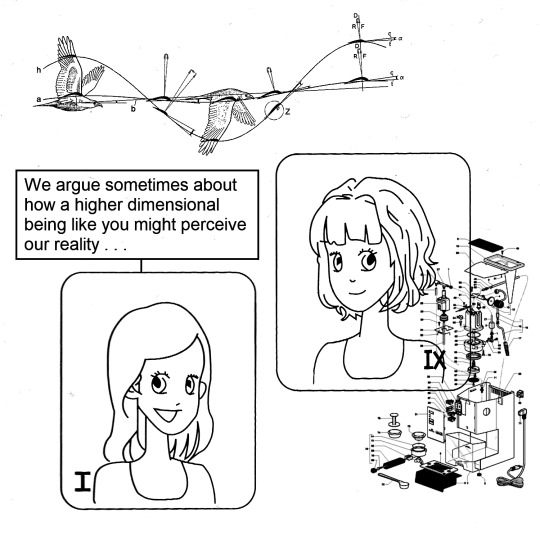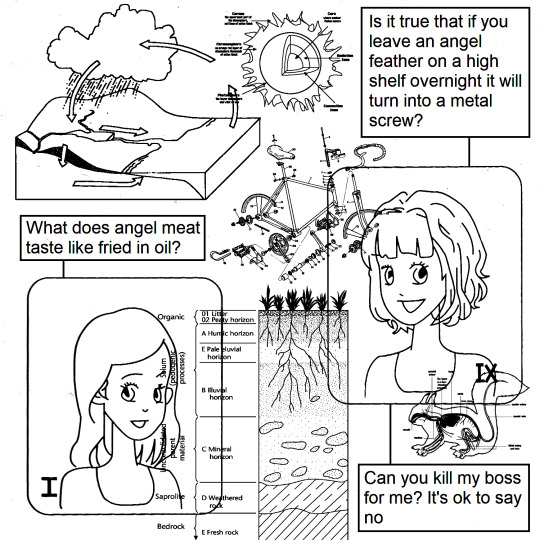Text
Video essays that make me go “oh, so you’re like smart smart”
Elon Musk and Grimes: A Retrospective
Bo Burnham vs. Jeff Bezos
The Systemic Abuse of Celebrities
Lana Del Rey: the pitfalls of having a persona
we need to talk about Call Me By Your Name
MYTH OF THE AUTEUR: Stanley Kubrick vs David Lynch
In Search Of A Flat Earth
Envy
The Commodification of Black Athletes
The Lies Of The Lighthouse
The Green Knight: The Uncanny Horror of Masculinity
Time Loop Nihilism
How Bisexuality Changed Video Games
The Golden Age of Horror Comics - Part 1 (Part 2)
Weighing the Value of Director’s Cuts | Scanline
The True Horror Of Midsommar
Keep reading
56K notes
·
View notes
Text
video essays about horror, fear and dread
Films That Feel Like Bad Dreams
The Nightmare Artist
Fear of Big Things Underwater
Control, Anatomy, and the Legacy of the Haunted House
House of Leaves: The Horror Of Fiction
The History of Insane Asylums and Horror Movies
The Saddest Horror Movie You’ve Never Seen
Fear of Forgetting
Slender Man: Misunderstanding Ten Years Of The Internet
The Real Reason The Thing (1982) is Better than The Thing (2011)
The Bizarre Clown Painting No One Fully Understands
The Little Book of Cosmic Horrors
The Disturbing Art of A.I.
Fear of Depths
Goya’s Witches
David Lynch: The Treachery of Language
The True History That Created Folk Horror
The Existential Horror of David Cronenberg’s Camera
more under the cut
Keep reading
58K notes
·
View notes
Text
The Joker: A Comic Masterlist
Disclaimer: This list will be subject to changes (comic addition and comic removal), as well as possible changes to its labeling system as this list is continually adjusted. If you see that a certain comic is missing please message me and make sure to include the comic's official title, number, and series of origin. The timeline organization of both single issue and collected editions is based on biased research.
Single issues with several following numbers are to be read as a collected edition.
This list will also include a link to where the comics below can be read for free.
Batman Comic's 1940 to 2011
These single-issue comics follow the familiar formula of, 'hero catch's villain'. In my opinion, they really showcase Joker's goofiness and criminal intelligence.
Batman #1, Batman #4, Batman #5, Batman #7, Batman #11
Batman #16, Batman #23, Batman #37, Batman #40
Batman #44, Batman #55, Batman #73, Batman #148
Batman #163, Batman #251, Batman #286, Batman #291
Batman #294, Batman #321, Batman #450, Batman #451
Batman #496, Batman #546, Batman #563, Batman #570
Batman #596, Batman #614, Batman #625, Batman #643
Batman #650, 649, 648 (Jokers more, 'there in the background')
Batman #655, Batman #663
BATMAN R.I.P: #676, 678, 679, 680, 681, 682
Batman Detective Comics 1937 - 2011
Batman DC #124, Batman DC #128, Batman DC #149, Batman DC #168
Batman DC #180, Batman DC #193, Batman DC #332, Batman DC #341
Batman DC #338, Batman DC #365, Batman DC #475, Batman DC #476,
Batman DC #532 Batman DC #569, Batman DC #570, Batman DC #617,
Batman DC #623 Batman DC #661, Batman DC #737, Batman DC #740,
Batman DC #741, Batman DC #781 Batman DC #826,
Batman DC #870, 869, 867, 866
Batman DC #875, Batman DC #879, Batman DC #880,
Link to comic Here
Gotham Central
Issues #12-15
Link to comic Here
Batman Confidential
Issues #7-12
Link to comic Here
Batman: The Man Who Laughs
Batman The man who laughs explores the idea of what would Batman and Joker's relationship look like if it had continued from Batman #1.
Link to comic Here pgs 1-70
Joker #1-15 2021 AND The Joker: Clown Prince of Crime (1975-76) series
The Joker: Clown Prince of Crime Series is a spin-off series with other villains such as Lex Luther, The Riddler, The Creeper, and more.
Joker 2021 #1-15 is a different series following the events of Infinite Frontier #1 involving Jim Gordon getting contracted to kill the Joker. To best understand this series I would suggest reading Batman: The Killing Joke, Joker War, and Black Mirror first.
This link will give you access to both collected editions.
Batman: The Killing Joke
Originally released in 1988, Batman: The Killing Joke was adapted from the 1951 short story The Man Under The Red Hood. This comic was also adapted into an animated movie in 2016.
Link to comic Here
Batman: A Death In The Family
A Death in the Family begins when Batman relieves Jason Todd of his crime-fighting duties. Jason begins a search for his biological mother but ends up being tortured by The Joker. This leads to his presumed death.
Link to comic Here
The Three Jokers
The Three Jokers is a 'spiritual' successor to Batman: The killing Joke and Batman: A Death In The Family. Batman, Batgirl, and Red Hood (now Jason Todd) explore a lead on The Joker, who, as the title suggests may have been 3 different men this whole time.
Link to comic Here
Batman Europa
Batman is about to be taken out by a virus that has no cure and his only salvation is The Joker.
Link to comic Here
Singular Stories
Batman: Cacophony
The major plotline is that someone has taken the Joker's poison and created a new club drug called Chuckles. It's taking over the street scene.
Link to comic Here
Jokers Last Laugh
Joker finds out he has cancer and starts a riot
Link to comic Here
Batman: Joker Switch
Joker gets a joke played on HIM! TW: Body horror
Link to comic Here
Batman: Dark Detective
Joker attempts to run for president
Link to comic Here
Batman: Joker Times
Joker agrees to be psychoanalyzed on live TV
Link to comic Here
Batman: I, Joker
Link to comic Here
BATMAN NEW 52 2011 - 2015
Batman New 52 carries multiple Joker storylines. Below I have sectioned them out for your consumption:
Death Of The Family: Batman New 52: #13 - #17
Batman Zero Year starts #21 and we see Joker's first appearance in Zero Year in issue #23.1 and then again in #24. Batman Zero Year then ends and
Batman Endgame begins at #34 - 40.
From #41 - #52 onward we begin Batman: Superheavy and start to tell the story of Mister Bloom. This storyline also leads to the amnesia of Bruce Wayne and the retired Joker storyline.
Link to full comic Here
Batman Detective comics faces of death VOL 1
Batman Faces of Death: #1 pgs 1-30 (Joker gets his face cut off by Dollmaker)
Link to comic Here
Batman: Death Of The Family (Extra)
This version of Death Of The Family also contains Detective Comics 16-17, Catwoman 13-14, Batgirl 14-16, Red Hood and the Outlaws 15-16, Teen Titans 15, Nightwing 15-16, Batman and Robin 15-17, Batman 17.
Link to comic Here
Batman: Zero Year ARC 2
Arc 2 of Batman's Zero Year is titled Secret city. We delve into Bruce Wayne’s past with the Red Hood Gang and his run-ins with aspiring District Attorney Harvey Dent!
Link to comic Here
Arkham Unhinged
I have never read this and do not know what it is about but it seems to have a similar format to Legends of The Dark Knight.
Joker is in issues: #7-9, #26-31, #35-37
Link to comic Here
Legend of the dark knight (1989-2021)
These are stories that can be told anywhere in the timeline, past, present, and future.
The 2021 run: Joker is in issues 2 and 3
Link to comic Here
The 2015 run: Joker is in issues, #4-6, #7-10,
Link to comic Here
The 1989 run: Joker is in issues, #50, #65-68, #105-106, #142-145, #162-163, ##200
Link to comic Here
BATMAN: REBIRTH 2016
Batman Rebirth carries out multiple Joker storylines. Below I have sectioned them out for your consumption:
Batman Rebirth: #25
Batman Rebirth #26-32 The War of Jokes and Riddles'
Batman Rebirth #48-50 The Best Man
Batman Rebirth #66
Batman Rebirth #86-91 Their Dark Designs (this leads into the Joker war)
Batman Rebirth #93 - #101, The Joker War
Link to comic Here
Journey to the joker war is just a fun little prelude to the joker war #1023 and 1024
The Joker War (Extra scenes)
As part of the Batman: Rebirth series Joker manages to steal Bruce Wayne’s fortune. With his newfound riches, he proceeds to take over Gotham city leading to an epic, explosive, battle.
Link to comic Here
Joker war collateral damage, the aftermath of the joker war.
Doomsday Clock
Doomsday Clock is a story about what happens when Doctor Manhattan, in all his logic and power, becomes aware of the inherently illogical, nonlinear main DC continuity
Joker shows up in issues; 4-7
Link to comic Here
2019 Onward...
Batman: Last Knight On Earth
This is not part of any series and is under a black label meaning its not part of the DC continuum
Link to comic Here
Joker Killer Smile
Joker gets psychoanalyzed.
Link to comic Here
The Joker Presents: A puzzle box
The G.C.P.D have a mysterious corpse, a magical box, and a murderer's row of the city's most dangerous villains sitting in a jail cell. Now all they need to figure out is what exactly happened.
Link to comic Here
The Joker: The Man Who Stopped Laughing
The world once again holds its breath as The Joker strikes again! But how far is he willing to go this time?
Link to comic Here
Thank you, everyone. Please don't forget to reblog and share!
@lankylordoflevity @katekanemybeloved @killerant @unordinaryachilles @luxamea @the-hopeless-fanboy @gothamsfinestdummy @muslyedirector @icedgarlic @gothamurbanist @creature-of-the-night-esq
#no one look at me I’m entering my batjokes era#scratch that I’ve been in the trenches for a month#batjokes#comics#joker#Batman#dc
219 notes
·
View notes
Text

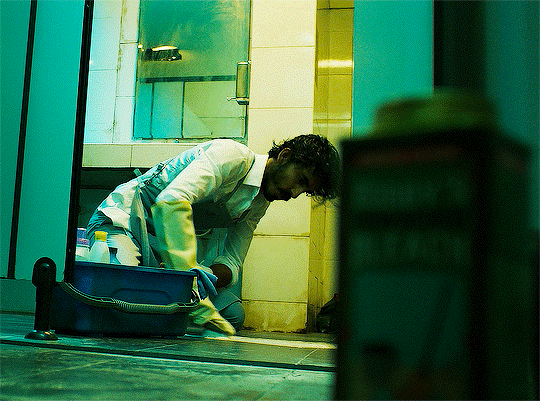


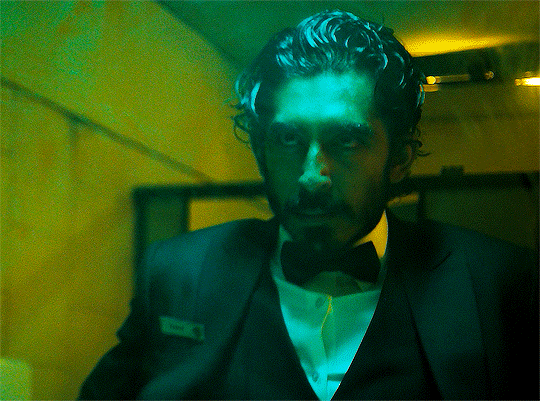
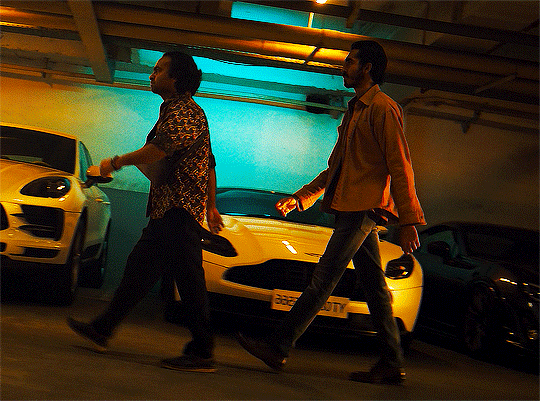


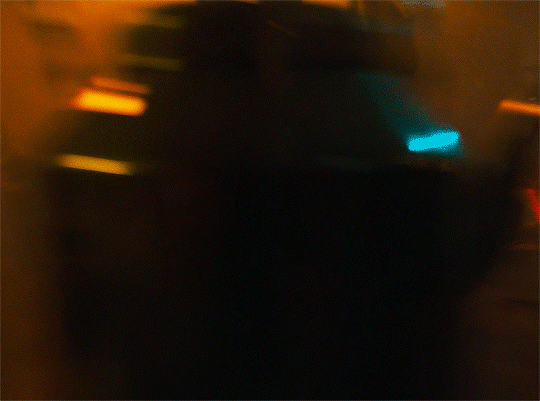

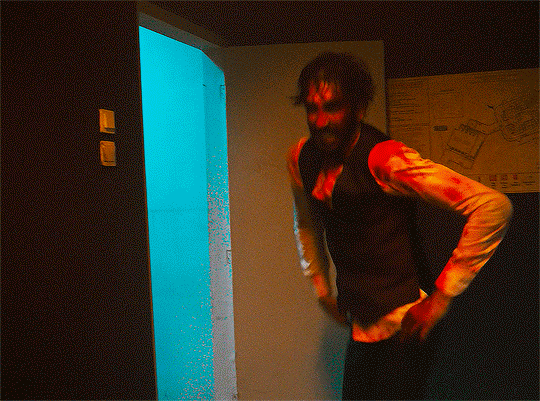

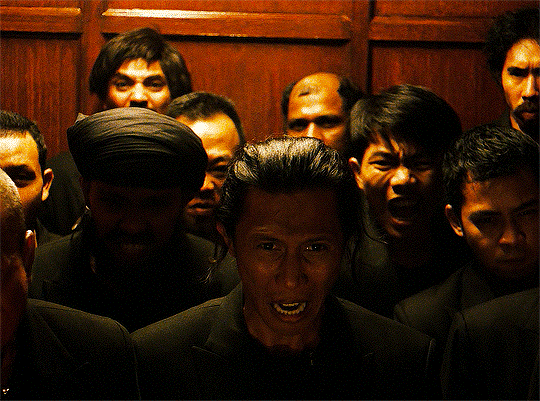
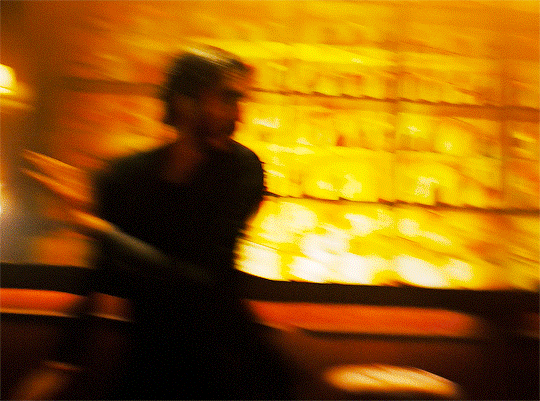
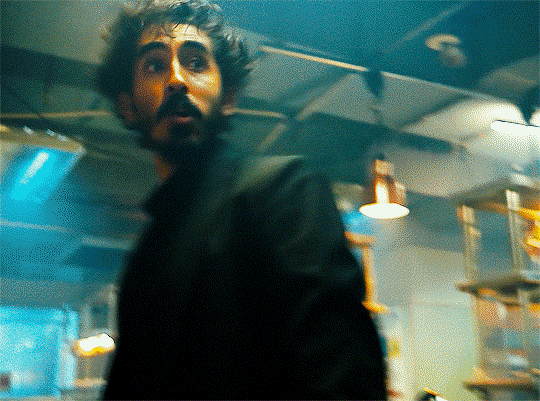


Monkey Man (2024) dir. Dev Patel
6K notes
·
View notes
Text


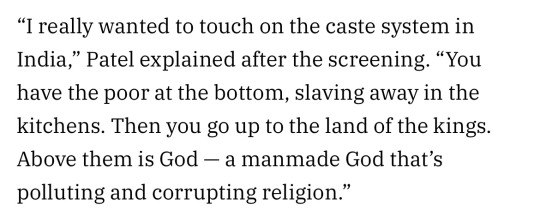
Dev Patel on Monkey Man
“The action genre has been abused by the system. You know, a quick buck. Mindless shit. I wanted to give it soul. Real trauma. Real pain. You guys deserve that. I wanted to infuse it with a little bit of culture.”
“I really wanted to touch on the caste system in India. You have the poor at the bottom, slaving away in the kitchens. Then you go up to the land of the kings. Above them is God — a manmade God that’s polluting and corrupting religion.”
7K notes
·
View notes
Text
Violence and Love in Monkey Man

Dev Patel's Monkey Man has played at my mind for two weeks now. This is for reasons that I'm able to articulate and for many that I probably have not yet been able to find the words for. This post is, in part, my attempt at sorting through some of my thoughts. My tumblr is all spoilers all the time. If you don’t want that, then please don’t read on.
Violence
Like most places in the world, systemic violence is a scourge in India. Monkey Man does not shy away from this reality and depicts Hindu nationalist state violence and violence against women and gendered minorities in the country to chilling effect.
We come to see this in the brutal rape and murder of Kid's activist mother at the hands of the police, while she tries to shield her child and her land from police and state terror. We see it in the treatment of (largely femme-presenting) sex workers in the two brothels featured in the film, including one frequented by the police and political elite. We see it in the violence and ostracisation meted out against the hijra, or third gender community by individual actors and the state more broadly. We see it in the state-orchestrated razing of an entire community after the land on which it sits is declared a "holy site". We see it in the movement of people from the regions to the city after their land has been stolen and the grinding poverty they face as a result.

Unlike so many action films, none of the violence in Monkey Man occurs in a vacuum. Even Kid's original means of making money in an underground fighting ring is done against the backdrop of his forced displacement from regional India to the city - a migration pathway that many in the country have been forced to take and which is a direct result of land theft and resource extraction in the regions by local and multinational corporations as well as federal and state governments.
The truth is that so much in relation to state and societal control is enacted in painful and violent ways on the bodies of the marginalised and oppressed. And I often think about how the horror and action genres are some of the best suited to speak about systemic injustice because of their capacity to make that violence uncompromisingly visible (one recent example is Mike Flanagan’s Midnight Mass which depicted the bloody fallout of the Christian missionary/colonial project in vivid crimson, splashed all over a non-descript maritime town in present-day America). The violence in Monkey Man is no different.
While Kid's realisation of the interconnectedness and heavy hand of the state not just in the violence experienced by his mother, but also by the hijra, and by sex workers like Sita comes later in the movie, we as the audience are given this insight earlier. Recall Kid pointing out to Sita that her tattoo is of a koel, not a sparrow as originally misidentified by the Australian client sexually assaulting her minutes earlier in the film.
Kid goes on to say that he grew up in the forest and woke up to koels singing everyday. Its the longest conversation that the two have but in those brief words, we understand that Sita too has likely been displaced to the city from the regions, probably under very similar circumstances to Kid. The way this displacement maps itself onto her body is distinctive to how it does so for Kid, with gender playing a large role in this.

Other factors like caste, class and religion also impact on how the characters in this film experience or perpetrate violence. I would write more on these intersections but then this post is going to get more unwieldy than it already is.
I will say though, that in India, where fascist Hindu nationalism is being used by government to harm minority communities, steal land and secure populist votes, Patel makes a distinction between revelatory and weaponised faith. Kid is raised in peace by his mother with the former, but as an adult he lives in a world where the latter has taken hold and is being used by those in power to shore up more of that power for themselves.
For me - as the descendant of parents, grandparents and great grandparents who lived through anti-Tamil pogroms led by Sinhalese chauvinists weaponising Buddhism as part of their fascism in Sri Lanka, who like the rest of us, is living in an election year for Hindu nationalist Prime Minister Narendra Modi in India, and who is also frustratingly, helplessly bearing witness as the state of Israel and it’s allies conflate Zionism with Judaism in defence of the genocide being waged against Palestinians - watching this action film make the distinction between revelatory and weaponised faith was profound.
Love
Patel makes it a point in this film to show how Kid's most nourishing relationships, the ones that sustain him - indeed the ones that literally save his life - are those that he has with women and with people who don’t conform to the gender binary. In doing this, we see what Kid is fighting tooth (quite literally) and nail for throughout the film. We see what is at stake - what we stand to lose - if perpetrators get to rule without accountability.
Its also no mistake that these relationships are all tied visually to the natural world in the film: Kid's mother's deep ties to the earth, rivers, trees and roots that she leads him through as a child. Alpha and the hijra's sanctuary, the Ardhanareeshvara temple with its most sacred space being the roots of a holy tree. Sita and her koel tattoo: the memory of the forest carried on her skin while she traverses the brutal reality of the city. Patel is making a point here too. About nourishment of another kind, through our connection with the earth instead of extraction from it. The visuals in the film drive this point home, particularly when contrasted with the industrialisation and poverty of the city.
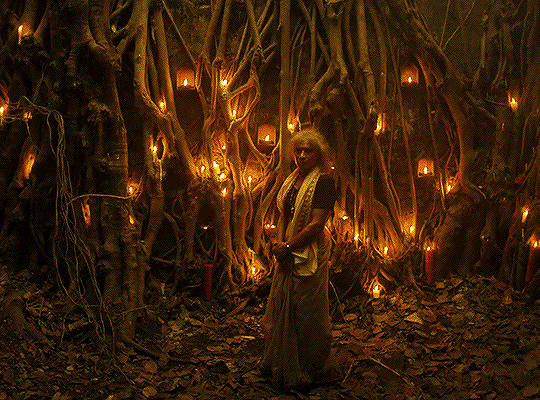
Two particular loving relationships that stood out for me were the love shared between Kid and the hijra community as well as between him and his mother.
Alpha, hijra Elder and the hijra community
Keeper of the Ardhanareeshvara Temple and hijra Elder, Alpha becomes a mother-figure to Kid after he is rescued with near-fatal injuries. It is Alpha who keeps watch over him as he recovers, helps Kid to confront the totality of his past memories which his trauma has kept fragmented, and who ultimately leads a veritable hijra army to join forces with him to assassinate some fascists.
Alpha's gentleness with Kid was so moving to see, in particular during the conversation they have about his attempt as a child to save his mother from the fire set by her rapist and murderer. That exchange moved me to tears.
Kid: I failed her.
Alpha: No. You tried to save her. You see scars. I see the courage of a child fighting to save his mother.

The wider hijra community at the temple also take Kid in and care for him during his recovery. Truly, the scenes at the temple were some of my favourite in Monkey Man. Outside of his memories of his mother, they are the only scenes where we see love, peace and joy on the faces of any of the characters in this film.

Also witness this moment of delight below as the hijra at the temple appreciate a fine ass man channelling his righteous anger and fucking up a punching bag full of rice. I note that the music during this training montage is simply stunning. Ustad Zakir Hussain's rapid fire tablas punctuated by each of Patel's landed punches and kicks and then followed by Jed Kurzel's achingly soaring instrumentals (listen to "The Kid" from the movie's score) were just *chef’s kiss*.

Another favourite moment for me was when Kid decides to go back to the underground fight ring one last time and not throw his matches (as he had been doing prior). He bets on himself and when he inevitably wins his fights, he takes the money and gives it to the hijra, ensuring that they can continue to live at the temple without fear of being evicted. We love to see a man who literally pays his rent.
Neela, his mother
Kid’s first teacher and the center of his life as a child. In almost every memory we are shown of her, Kid remembers his mother walking through a forest, sharing her ecological and religious knowledge with him and in doing so, positioning him within the wider world.

GIF by dailyflicks
We watch as he takes this understanding with him forward through the remainder of the film. His conversation as an adult with Alphonso as they drive through the city in the latter's tuk tuk is emblematic of this. "They don't even see us", Kid says of the elite who frequent the club where he has just gained employment, "they're all up there living and we are stuck in this."
His mother showed him what it was to live: to be still and in concert with the world and the Divine around you, to be loved fiercely, and to thrive as a result. This is in stark contrast to what Kid has had to learn to do in the city: to survive, to merely exist. He is never depicted resting or at home as an adult. He's always working, hustling and planning for the next thing, his next step. When he loses his village, his land and his mother as a child, Kid also inevitably loses his sense of home. It’s no coincidence that the tracks “Home” and “Mother” on the movie’s score sound almost identical.
Later at the end of the film, we see Kid close his eyes, having done what he set out to do. The last thing he sees is his mother, smiling at him in the forest. Her face is the face of God he gazes at before he succumbs to his injuries. This devotion to his mother is not just that of a child to a parent. Its also deeply tied to his Hindu faith which calls on its followers to honour the Divine Mother, the supreme feminine energy, Aathi Parashakthi, in all her manifestations including in those who mother us.
The movie ends with Kid’s deep, revelatory faith - instilled in him by his mother - and with the death of the man who weaponised that faith for power and wealth. It left all of us in the cinema seated in stunned silence even as the credits began to roll.

To describe Monkey Man as simply a revenge film does it an absolute disservice. This is not revenge. It is defence borne out of deep love for community and righteous opposition to injustice. Seeing hijra warriors dressed as Kali, the goddess of destruction, dealing death blows against fascists while spinning in the most beautiful lenghas was exhilarating (I literally screamed “YESSSSSSS!” at the screen when they arrived). Seeing Sita take out pimp Queenie got me cackling and yelling “whoooop!”. Seeing Kid, a masculine character act to defend women and people outside of the gender binary, from further systemic harm without any ulterior motive was absolutely unreal to witness on the big screen. Seeing a person of faith act in deep connection to that faith without judgment against anyone but those who perpetrate harm made me feel hopeful in a way that took me by surprise. Kid acted out of love and respect. I would argue that Sita, the hijra and Kid all acted out of recognition of a shared humanity.
And at a time when folks from marginalised communities are being subjected to horrendous violence worldwide, both interpersonal and systemic, watching the oppressed take their perpetrators out…and I mean out (see: a rapist and murderer getting bludgeoned to death with a glittery high heel and a fascist, self-proclaimed “holy man” being stabbed in his third eye by the blade he hid in his own “sacred” pathankal/paduka), well, it was cathartic to see.
Am I saying violence is the answer to systemic violence? I think the answer to that question is context-specific. Non-violent resistance has a place, but it’s by necessity a performance and requires an audience. What do you do when no one’s watching? What do you do when the people who are watching are doing nothing to stop your suffering? What then? These questions are what many liberals refuse to grapple with because the answers are too uncomfortable for their polite sensibilities. But if you keep your foot on someone's neck long enough, you should expect them to fight back, by any means necessary. In Monkey Man, we have an action film where we get to witness that resistance in all its visceral glory.
#monkey man#dev Patel#tw murder#tw violence#what a film guys…. what a film#I couldn’t put my finger quite on what made this so good#but OP did it perfectly#action
110 notes
·
View notes
Text
Wolf in White Van by John Darnielle is the best description of childhood emotional neglect I’ve ever read. When I picked it up and powered through it it made me feel extremely discomfited how much I related to the main character and why he did what he did, for supposedly no reason… just like some odd thoughts I had at a very young age… and now to have the vocabulary for it is very strange, and to know exactly why I related is interesting to say the least. I also turned to addictive media behaviour and boredom is still my worst enemy. It’s a lot
0 notes
Text
seized by the urge to start a list of aroace media that isn’t like. Children’s lit - or at least media that is aroace coded to me! It’s hard to find media that sheds light on it
Some aroace coded things (to me):
Annihilation (the books specifically. The main character, despite being married, honestly doesn’t seem that into her husband and reads to me as aroace)
Venom (venom can read as an extension of Eddie… lives in his body… sort of like dating yourself if a part of you has conflicting needs/wants)
Maniac (the tv series wow I love to see male-female friendship)
Little Women (Jo March aroace icon)
I’m Your Man - Mitski
Fairlies - Grian Chatten
It’s Only Sex - Car Seat Headrest
Thursday - Peach Pit
I will continue this list when my memory returns, feel free to contribute!
29 notes
·
View notes
Text
The Hole (2014) - Hiroko Oyamada

Rating: 4/10
A horror novella that bears witness to a couple uprooted; a woman is swept to the countryside in her wake of her husband’s job relocation. There she falls down a series of metaphorical holes - the trappings of being a housewife, an oppressive summer heat, the cyclical motions and assumed roles of family and holes that take you elsewhere. And, not surprisingly, for a book about holes, yes she does literally fall into a hole - a perfect hole, as if it was made for her and her alone.
I wasn’t completely taken by this book; it felt as though the surrealism was forced, as though there were too many trappings of reality such that the weirdness couldn’t really take flight. I don’t so much mind surrealism in Murakami’s work, which this echoes; his worlds are already bloody weird. Likewise, the ongoing commentary here on society, capitalism and family values wasn’t as strong as the otherworldly work of Sayaka Murata, in which the main characters themselves are untethered, or Yoko Ogawa’s Memory Police, in which the world itself is strange.
I felt that the ending was a bit of a cop out, and that a character was randomly introduced halfway with no real build-up to it. Similarly, other characters were under-utilised. Severance by Ling Ma was more successful in exploring cycles of repetition.
Still, considering the work on its own without comparison, it was a pleasant short read though occasionally frustrating due to the character’s own incredible lack of agency, though maybe, in hindsight that was rather the point, as if she were stuck in a spiritual hole, blind to her confines. I don’t regret reading this but it won’t necessarily go on my recs list. If you want a horror novel about holes I’d direct you to ‘The Cipher’ by Kathe Koja, one of my favourite books of all time.
#hiroko oyamada#the hole#literature#book blog#book review#booklr#horror novel#horror fiction#japanese novel#surrealism#books
0 notes
Text
Blood Meridian; or, the Evening Redness in the West (1985) - Cormac McCarthy

Rating: 10/10
Reading this novel was like being reminded that evil persists, exists, is stoked by the mechanisms that people before us have carefully or carelessly put into place, perpetuated by sons that learn only violence from their fathers, hoping for easy solutions, for another whiskey or another fuck, onward into infinity like dancing bears on a very vast and dusty stage made of wood planks with ancient blood pooled in its cracks.
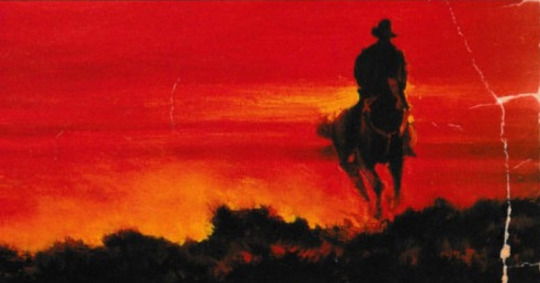
Just like its subject - the scalp trade in the Borderlands - McCarthy’s writing here is difficult to digest, forces you to slow down and absorb the horrors in their entirety. He lists these in excruciating detail - the gang commits massacre after massacre, unnecessary violence against innocent people, violence against people who fight back, violence against the people who employed them in the first place. All of these horrors are both fictional and real, based upon the actions of a real-life figure and leader of said gang, John Joel Glanton and his mysterious right-hand man, the Judge.
Yet McCarthy chooses to focus on the Judge as representative of true evil; supernatural in appearance, actions and worldly knowledge, the Judge states that “Whatever exists in creation without my knowledge exists without my consent.” After he records it tidily in his journal, we see him snuff out centuries, millennia-old example of human art with one giant hand - a scene that struck me strangely hard, considering that we had just seen him kill countless people, had been implied to harm children in unspeakable ways, had played the gang like a cruel fiddle for nothing but nihilistic enjoyment. And yet he is symbolically an imperialist symbol, consuming everything since he seems to truly believe in nothing but the tune of war and games of chance. No judge in the sense of justice - he holds court only in bloodsport and bloodshed.
And yet we see The Kid, our true protagonist, also born with a propensity of violence, show mercy; he helps; he is moved; he is unswayed by the Judge’s simplistic philosophy couched in the words of a skilled orator. We see him move on and become The Man. We see him kill, still; but he warns, he attempts to rescue others, he wants nothing to do with the game. He quits it entirely. His soul remained intact, and what happens at the end of the book… only happened because the Judge knew no other way to subdue it. And I think that gives me hope.
—
Personal note: I finished this book over a VERY long stretch - give or take 6+ months - but it was worth it in the end. I’m not necessarily a fan of historical novels, nor epic works, but occasionally I work myself up to it. I’m looking to maybe read Cormac McCarthy’s The Road next now that I’m used to his meandering style. I’m curious to know what people think about this book too though I’m aware that it’s already been dissected to bits and pieces everywhere on the literary internet and in reading groups and in universities.
A must-read for people unfamiliar with extreme violence and conflict, or those who want to learn about the Borderlands at the time, or if you just want to read beautiful descriptions of disgusting violence and a gorgeous, unfeeling and dangerous landscape.
#book review#Cormac McCarthy#historical fiction#booklr#bookish#book blog#American literature#literature#blood meridian#borderlands#tw: violence#tw: implied csa#tw: death#tw: genocide#tw: gun violence#tw: animal death#books
2 notes
·
View notes
Text
reading Mary Oliver’s essays in between this long slog through Cormac McCarthy’s Blood Meridian is like having brief respite from unimaginable torture to go stare at some weeds and find in them strange yet delicate and profound beauty and then it’s back to the indiscriminate murder and scalping alongside the most beautiful descriptions of wastelands I have ever witnessed with my own two eyes
something something ugliness of human nature something something sanctuary in nature nature
4 notes
·
View notes
Text
Here's THE masterpost of free and full adaptations, by which I mean that it's a post made by the master.
Anthony and Cleopatra: here's the BBC version
As you like it: you'll find here an outdoor stage adaptation and here the BBC version
Coriolanus: Here's a college play, here's the 1984 telefilm, here's the 2014 one with tom hiddleston
Hamlet: The Kenneth Branagh 1996 Hamlet is here, the 1964 russian version is here and the 1964 american version is here. THe 1964 Broadway production is here, the 1948 Laurence Olivier one is here. And the 1980 version is here. Here are part 1 and 2 of the 1990 BBC adaptation. Have the 2018 Almeida version here.
Henry IV: part 1 and part 2 of the BBC 1989 version. And here's part 1 of a corwall school version.
Henry V: Laurence Olivier (who would have guessed) 1944 version. The 1989 Branagh version here. The BBC version is here.
Julius Caesar: here's the 1979 BBC adaptation, here the 1970 John Gielgud one.
King Lear: Laurence Olivier once again plays in here. And Gregory Kozintsev, who was I think in charge of the russian hamlet, has a king lear here. The 1975 BBC version is here. The Royal Shakespeare Compagny's 2008 version is here. The 1974 version with James Earl Jones is here.
Macbeth: here's the 1961 one with Sean Connery. Here's the 1971 by Roman Polanski, with spanish subtitles. Here's the 1948 www.youtube.com/watch?v=ljZrf_0_CcQ">here. The 1988 BBC onee with portugese subtitles and here the 2001 one). The 1969 radio one with Ian McKellen and Judi Dench is here and the 1966 BBC version is here. The Royal Shakespeare Compagny's 2008 version is here.
Measure for Measure: BBC version here.
The Merchant of Venice: here's a stage version, here's the 1980 movie, here the 1973 Lawrence Olivier movie, here's the 2004 movie.
The Merry Wives of Windsor: the Royal Shakespeare Compagny gives you this movie.
A Midsummer Night's Dream: have this sponsored by the City of Columbia, and here the BBC version.
Much Ado About Nothing: Here is the kenneth branagh version and here the Tennant and Tate 2011 version. Here's the 1984 version.
Othello: A Massachussets Performance here, the 2001 movie her is the Orson Wells movie with portuguese subtitles theree, and a fifteen minutes long lego adaptation here. THen if you want more good ole reliable you've got the BBC version here and there.
Richard II: here is the BBC version
Richard III: here's the 1955 one with Laurence Olivier, and here's the 1995 one with Ian McKellen. (the 1995 one is in english subtitled in spanish. the 1955 one has no subtitles and might have ads since it's on youtube)
Romeo and Juliet: here's the 1988 BBC version.
The Taming of the Shrew: the 1988 BBC version here, the 1929 version here, some Ontario stuff here and here is the 1967 one with Richard Burton and Elizabeth Taylor.
The Tempest: the 1979 one is here, the 2010 is here. Here is the 1988 one.
Timon of Athens: here is the 1981 movie with Jonathan Pryce,
Troilus and Cressida can be found here
Titus Andronicus: the 1999 movie with Anthony Hopkins here
Twelfth night: here for the BBC, herefor the 1970 version with Alec Guinness, Joan Plowright and Ralph Richardson.
The Winter's Tale: the BBC version is here
Please do contribute if you find more. This is far from exhaustive.
(also look up the original post from time to time for more plays)
56K notes
·
View notes
Text
What a day to be recommended a film by my professor only to discover that the lead actress is Isabelle Adjani, and what a day to recommend Possession to said professor
7 notes
·
View notes
Text



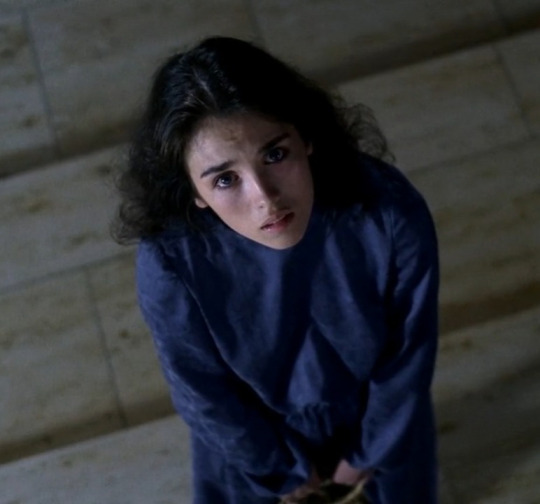

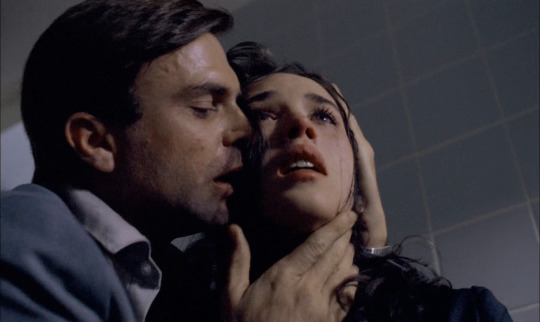

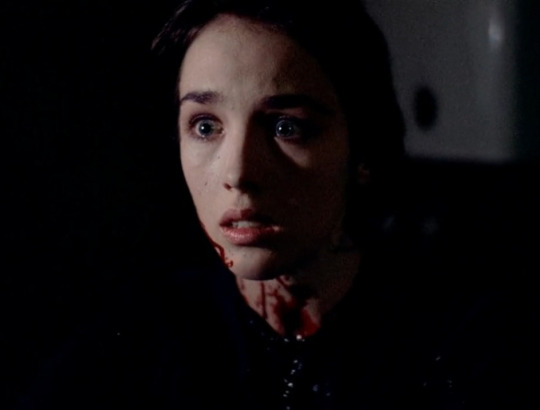
Xiu Xiu, At Last, At Last // Possession (1981)
44 notes
·
View notes
Text
2 notes
·
View notes
Text
🎥 CREEP (2014) ALTERNATE ENDINGS
youtube
14 Nov 2022 | Day 7/∞: Creep (2014)
25 notes
·
View notes

